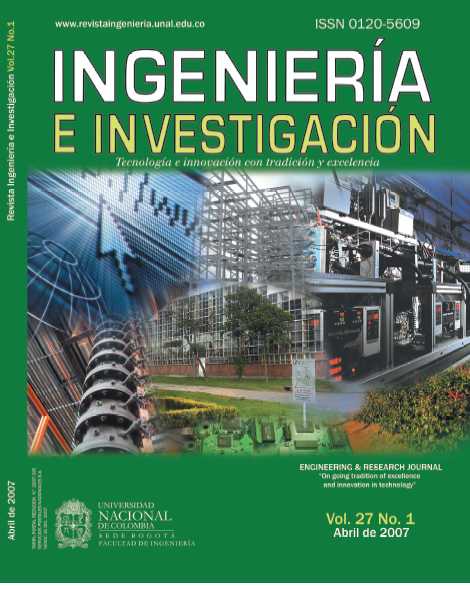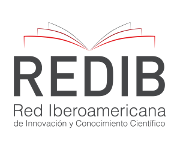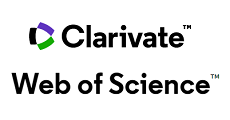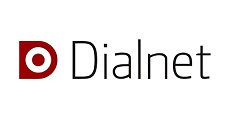Characterising mechanical transmission wire ropes’ typical failure modes
Caracterización de modos de falla típicos en cables de transmisión mecánica
DOI:
https://doi.org/10.15446/ing.investig.v27n1.14784Keywords:
failure analysis, wire rope, failure mode, fracture, wear, corrosion (en)análisis de falla, cables de transmisión mecánica, modos de falla, fractura, desgaste, corrosión (es)
Downloads
The National University of Colombia’s Engineering School’s AFIS research group has helped several public and private institutions during the last five years in analysing the causes of failures presented in elevation and transport machinery leading to expensive consequences and even the loss of life. A group of typical wire rope failure modes have been identified, along with their common causes. These are presented in this work to offer help to our industry’s engineers and technicians, allowing them to identify possible risk situations in their routine work regarding the wire ropes which they use and approaches for carrying out wire rope failure analysis.
El grupo de investigación AFIS de la Facultad de Ingeniería de la Universidad Nacional de Colombia sede Bogotá D.C., ha asesorado durante los últimos cinco años a varias instituciones públicas y privadas en el análisis de las causas de fallas que se les han presentado en maquinaria de elevación y transporte con costosas consecuencias e incluso pérdida de vidas. Se ha identificado un conjunto de modos de falla típicos de cables con sus causas comunes, los cuales se detallan en el presente trabajo para de esta manera brindarle a ingenieros y técnicos de nuestro medio una ayuda que les permita identificar en su trabajo rutinario posibles situaciones de riesgo en la forma de operación de los cables de transmisión mecánica que utilizan y criterios para llevar a cabo análisis de falla de los mismos.
References
Chaplin, C.R., Torsional failure of a wire rope mooring line during installation in deep water., Engineering Failure Analysis, Vol 6, 1998, pp. 67 - 82. DOI: https://doi.org/10.1016/S1350-6307(98)00043-0
Chaplin, C.R., Failure Mechanisms in Wire Ropes., Engineering Failure Analysis, Vol 2, No. 1, 1995, pp. 45 - 57. DOI: https://doi.org/10.1016/1350-6307(95)00004-A
De Silva and Long Woon Fong, Effect of abrasive wear on the tensile strength of steel wire rope., Engineering Failure Analysis, Vol 9, 2002, pp. 349 - 358. DOI: https://doi.org/10.1016/S1350-6307(01)00012-7
Hernández, H. y Espejo, E., Mecánica de fractura y análisis de falla., Unibiblos, Bogotá, 2002, pp.120.
Kuruppu, M.D., Tytko, A. and Golosinski, T.S., Loss of metallic area in winder ropes subject to external wear., Engineering Failure Analysis, Vol 10, 2003, pp. 395 - 404.
Parameswaran, P., Raghunathan, V.S., Hiremath, S.C. and Paknikar, K.R., Failure of locked coil wire rope of coal handling system., Engineering Failure Analysis, Vol 10, 2003, pp. 395 - 404. DOI: https://doi.org/10.1016/S1350-6307(03)00019-0
Torkar, M. and Arzensek, B., Failure of crane wire rope., Engineering Failure Analysis, Vol 9, 2002, pp. 227 - 233. DOI: https://doi.org/10.1016/S1350-6307(00)00047-9
How to Cite
APA
ACM
ACS
ABNT
Chicago
Harvard
IEEE
MLA
Turabian
Vancouver
Download Citation
CrossRef Cited-by
Dimensions
PlumX
Article abstract page views
Downloads
License
Copyright (c) 2007 Edgar Espejo, Juan Carlos Martínez

This work is licensed under a Creative Commons Attribution 4.0 International License.
The authors or holders of the copyright for each article hereby confer exclusive, limited and free authorization on the Universidad Nacional de Colombia's journal Ingeniería e Investigación concerning the aforementioned article which, once it has been evaluated and approved, will be submitted for publication, in line with the following items:
1. The version which has been corrected according to the evaluators' suggestions will be remitted and it will be made clear whether the aforementioned article is an unedited document regarding which the rights to be authorized are held and total responsibility will be assumed by the authors for the content of the work being submitted to Ingeniería e Investigación, the Universidad Nacional de Colombia and third-parties;
2. The authorization conferred on the journal will come into force from the date on which it is included in the respective volume and issue of Ingeniería e Investigación in the Open Journal Systems and on the journal's main page (https://revistas.unal.edu.co/index.php/ingeinv), as well as in different databases and indices in which the publication is indexed;
3. The authors authorize the Universidad Nacional de Colombia's journal Ingeniería e Investigación to publish the document in whatever required format (printed, digital, electronic or whatsoever known or yet to be discovered form) and authorize Ingeniería e Investigación to include the work in any indices and/or search engines deemed necessary for promoting its diffusion;
4. The authors accept that such authorization is given free of charge and they, therefore, waive any right to receive remuneration from the publication, distribution, public communication and any use whatsoever referred to in the terms of this authorization.




























